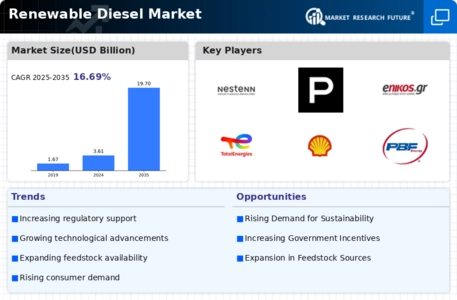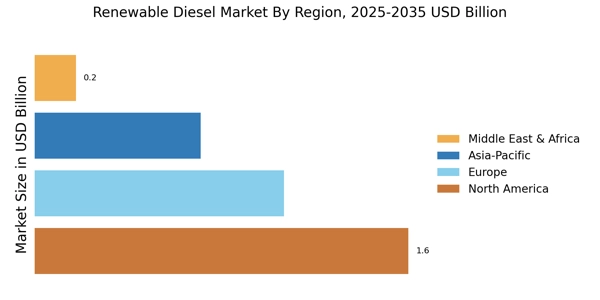Partnerships and Collaborations
Strategic partnerships and collaborations are emerging as a vital driver within the Renewable Diesel Market. Companies are increasingly joining forces to leverage each other's strengths, whether through technology sharing, joint ventures, or co-investments in production facilities. These collaborations can accelerate innovation and reduce the time to market for new renewable diesel products. In 2025, it is expected that the number of partnerships in the industry will rise, potentially leading to enhanced market dynamics. By pooling resources and expertise, companies can navigate regulatory challenges more effectively and capitalize on emerging opportunities in the renewable diesel sector.
Regulatory Frameworks and Policies
The Renewable Diesel Market is experiencing a robust influence from regulatory frameworks and policies that promote cleaner fuels. Governments are increasingly implementing stringent emissions regulations, which compel industries to transition towards renewable diesel. For instance, mandates for blending renewable diesel with traditional fuels are becoming commonplace, thereby driving demand. In 2025, it is estimated that the market could reach a valuation of approximately 30 billion USD, reflecting a compound annual growth rate of around 10%. This regulatory push not only enhances market stability but also encourages investments in renewable diesel production facilities, thereby fostering innovation and expansion within the industry.
Rising Consumer Awareness and Demand
Consumer awareness regarding environmental issues is significantly influencing the Renewable Diesel Market. As individuals and businesses become more conscious of their carbon footprints, the demand for sustainable fuel alternatives is on the rise. Surveys indicate that a substantial percentage of consumers are willing to pay a premium for renewable diesel, recognizing its benefits in reducing greenhouse gas emissions. This shift in consumer behavior is prompting fuel suppliers to increase their offerings of renewable diesel, thereby expanding market reach. By 2025, it is projected that the demand for renewable diesel could account for over 15% of the total diesel market, reflecting a growing preference for sustainable energy solutions.
Technological Innovations in Production
Technological advancements play a pivotal role in shaping the Renewable Diesel Market. Innovations in production processes, such as the development of advanced catalytic processes and feedstock flexibility, are enhancing the efficiency and cost-effectiveness of renewable diesel production. These technologies enable producers to utilize a wider range of feedstocks, including waste oils and agricultural residues, which could potentially lower production costs. As of 2025, the industry is witnessing a surge in the adoption of these technologies, which may lead to a more competitive market landscape. The integration of digital technologies, such as AI and IoT, is also streamlining operations, thereby improving overall productivity.
Investment in Renewable Energy Infrastructure
Investment in renewable energy infrastructure is a critical driver for the Renewable Diesel Market. As countries strive to meet their renewable energy targets, substantial capital is being allocated to develop production facilities and distribution networks for renewable diesel. This influx of investment not only enhances production capacity but also improves supply chain efficiencies. In 2025, it is anticipated that investments in renewable diesel infrastructure could exceed 20 billion USD, facilitating the establishment of new production plants and enhancing existing facilities. Such developments are likely to create a more resilient market, capable of meeting the increasing demand for renewable diesel.


















Leave a Comment